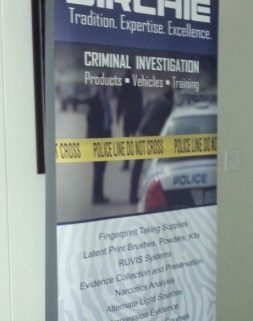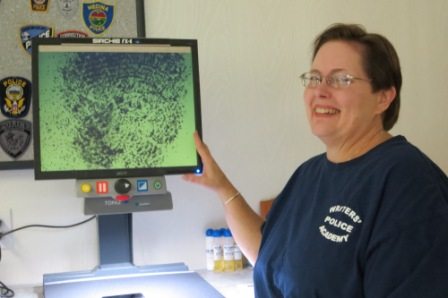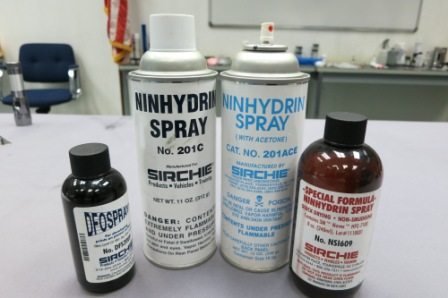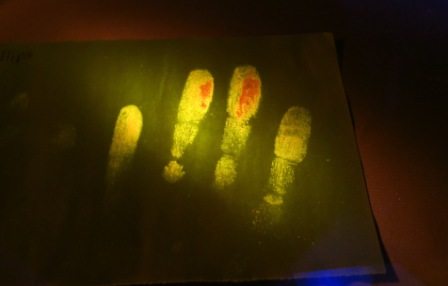Developing Prints With Chemicals: Day Two At Sirchie Fingerprint Laboratories
Day One at the Sirchie Fingerprint Laboratory Evidence Collection Training Class had been packed with information about various fingerprints powders and brushes used every day by an investigator or an examiner processing a crime scene. We had brushed, spilled, and breathed powder and then examined prints under a magnifier. We had played with the contrast colors on the Optical Comparator and discovered which colors ‘popped’ the ridges and whorls best for each of us. We forgot about the mess and enjoyed the discovery process. We found interesting ways for our own (fictional) criminals to challenge the system and our protagonists to catch ‘em and book ‘em without getting cases thrown out of court.
Take aways?
*Not all powders can be used on all surfaces.
*A print can dissipate over time and there are too many variables (temperature, humidity, condition of the surface, etc.) to predict how long that might take.
*A really crisp print can be photographed right at the scene, using some great digital cameras now available.
*Forensic science is not a certainty, even though TV shows may give that impression.
*There is no nationwide standard for number of points of ID for a fingerprint. The fact that the acceptable number of matching points (between the actual print and the print in the AFIS database) can range from 5 to 20 depending on where the perp lives, blew us away.
Day Two of Sirchie Evidence Collection training – by Patti Phillips
Day Two: Coffee ready. Snacks ready. Notebooks, cameras, smartphones, and pencils ready. Checking for leftover fingerprint powder on the magnifier. Ready.
Robert Skiff’s (Training Manager/Technical Training Specialist at Sirchie) assistant for the class, Chrissy Hunter, passed out stainless steel rectangles and we pressed our fingers onto the plates, twice. First time – plain ole print, second time – ‘enhanced’ by first rubbing our fingers on our necks and foreheads to increase the amount of oils in the print. The ridge detail in the prints was so clear in the ‘enhanced’ version that there was no need to process them with powder. We lifted them with a gel lift.
If we were working a real scene, that might never happen, but it could. The usual occurrence is that partial prints are left at the scene and that’s what makes the search for the perps sooooo much tougher than what the TV dramas indicate. There is no instant ‘a-ha’ moment that comes 45 minutes after the crime has been committed.
The prints are generally sent off to be compared with the millions in the AFIS database, and here’s where TV parts with reality again. AFIS comes back with a list of 10-20 possible matches and someone then makes a comparison by hand of the most likely hits.
After practicing the basics, it was time to move on to fingerprint discovery on documents. Documents? Yup. There are scheming relatives who forge wills, less than loving spouses who murder for the insurance, bogus suicide notes, and the list goes on. How to prove the nefarious intent? Fingerprints. But…as we discovered the first day, fingerprint powder is messy and almost impossible to clean up. An important document could be destroyed in the search for evidence of foul play. Enter chemicals and alternate light sources (ALS).
There is a protocol for testing with chemicals. If the prints don’t show up with one chemical, then it is possible to try several others, but this can only be done in a certain order:
Iodine
DFO
Ninhydrin
Silver Nitrate
MBD
If used in this order, the sample won’t be compromised, even though treated several times over several days.
We experimented with several chemicals with excellent results, but for the ‘wow’ factor, I’m showing the ones that look great on camera. 😉
DFO reacts to amino acids in the prints. We created our samples placing our own enhanced prints on plain white paper. We hung the papers in the fume hood, saturated them with DFO, then put them in the oven to bake for several minutes.
This DFO sprayed, baked sample doesn’t look like much, so it was time to use an ALS to really ‘pop’ the print and make it photo ready.
Alternate Light Sources vary depending on the scene lighting and/or need to highlight the evidence. A few used in the field are: the ‘poor man’s ultimate light source’ (a mag light), black lights, UVC lights, lasers, LED lights, Ruvis lights (cost about $20K), and pure white lights. Each has a specific quality that the investigators can tap when needed.
After we sprayed our samples with DFO and baked them in the oven, we darkened the room, and put on orange plastic glasses. Then we side-lit the sample with a 455nm light. The photo was taken at that point.
Same sample, side-lit at a slightly different angle. Photo taken through an orange filter.
Ninhydrin, the third chemical group in the list to be used if nothing has shown up yet, comes in several forms: acetone, zylene and Noveck. Ninhydrin reacts to another set of amino acids and likes warm, moist air. If a sample is being saved overnight for processing, you can place it in a ziplock bag, blow into it, then seal it and still maintain its integrity.
Before working with any chemical, it’s a good idea to make copies of the document. Why are there different kinds of Ninhydrin? Zylene will run some inks. Acetone will run all inks, all the time. Ooops! There goes the document if you grab the wrong chemical, so copies are definitely necessary. Noveck is the clear winner when working with inks. It gets fast results and dries quickly. Additionally, it can be sprayed on an outer envelope to reveal what’s inside. Without damaging either piece of paper. Very cool.
You could see the plots developing in our writerly heads as the Noveck dried and the words inside the folder faded from view.
Next up: the Sirchie Tour
Patti Phillips is a mystery writer/photographer/reviewer whose best investigative days are spent writing, cooking, traveling for research, and playing golf. Her time on the golf course was murderously valuable while creating the perfect alibi for the chief villain in Patti’s novel, “One Sweet Motion.” Did you know that there are spots on the golf course that can’t be accessed by listening devices? Of course, it helps to avoid suspicion if you work on lowering your handicap while plotting the dirty deeds.
Patti Phillips writes the online detective blog, www.kerriansnotebook.com. (Detective Kerrian chats about life as a detective as well as the central case in “One Sweet Motion.”) Patti’s book reviews of mysteries and thrillers can be found on the Facebook, Amazon, and Barnes & Noble sites. Her own review site, ‘Nightstand Book Reviews’ is coming soon.
Patti is a transplanted metropolitan New Yorker/north Texan, now living in the piney state of North Carolina.














Kathy – agreed! 🙂
WOW how interesting and fascinating all the things that are available to help.
Hi Melanie! That photo was too perfect with that big smile. Had to use it! 🙂
Elizabeth, I agree with Melanie. The fact that the prints were protected (by being inside the glove) made retrieval possible.
I’d say yes, especially since the prints were on the inside of the glove.
On The Closer last night, forensics were able to retrieve a usable print from the inside of a latex glove after the glove had gone through the entire digestive system of a bulldog. In view of temperature, humidity, etc that was mentioned above as causing prints to dissipate, was this possible in real life?
Hey, that’s me in the pic with the giant fingerprint! I learned so much over those five days… and I’m already incorporating it into my writing. Such a fabulous opportunity.